鲁教版五四制初二英语unit6教案【超详细】烟台威海地区
- 格式:doc
- 大小:163.50 KB
- 文档页数:9
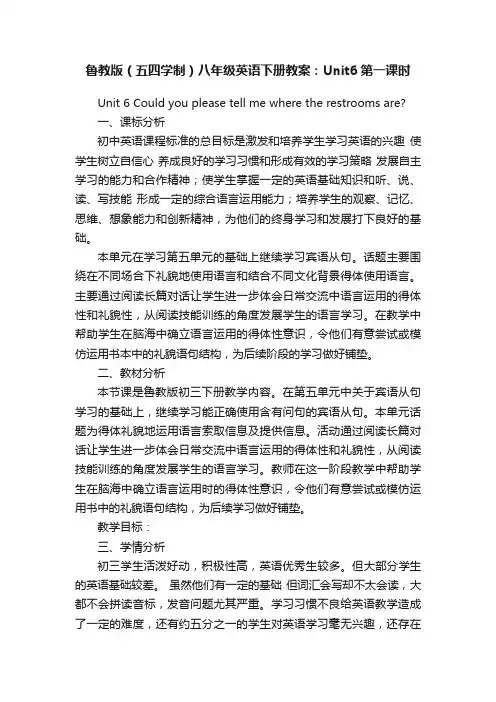
鲁教版(五四学制)八年级英语下册教案:Unit6第一课时Unit 6 Could you please tell me where the restrooms are?一、课标分析初中英语课程标准的总目标是激发和培养学生学习英语的兴趣使学生树立自信心养成良好的学习习惯和形成有效的学习策略发展自主学习的能力和合作精神;使学生掌握一定的英语基础知识和听、说、读、写技能形成一定的综合语言运用能力;培养学生的观察、记忆、思维、想象能力和创新精神,为他们的终身学习和发展打下良好的基础。
本单元在学习第五单元的基础上继续学习宾语从句。
话题主要围绕在不同场合下礼貌地使用语言和结合不同文化背景得体使用语言。
主要通过阅读长篇对话让学生进一步体会日常交流中语言运用的得体性和礼貌性,从阅读技能训练的角度发展学生的语言学习。
在教学中帮助学生在脑海中确立语言运用的得体性意识,令他们有意尝试或模仿运用书本中的礼貌语句结构,为后续阶段的学习做好铺垫。
二、教材分析本节课是鲁教版初三下册教学内容。
在第五单元中关于宾语从句学习的基础上,继续学习能正确使用含有问句的宾语从句。
本单元话题为得体礼貌地运用语言索取信息及提供信息。
活动通过阅读长篇对话让学生进一步体会日常交流中语言运用的得体性和礼貌性,从阅读技能训练的角度发展学生的语言学习。
教师在这一阶段教学中帮助学生在脑海中确立语言运用时的得体性意识,令他们有意尝试或模仿运用书中的礼貌语句结构,为后续学习做好铺垫。
教学目标:三、学情分析初三学生活泼好动,积极性高,英语优秀生较多。
但大部分学生的英语基础较差。
虽然他们有一定的基础但词汇会写却不太会读,大都不会拼读音标,发音问题尤其严重。
学习习惯不良给英语教学造成了一定的难度,还有约五分之一的学生对英语学习毫无兴趣,还存在抵触情绪,给英语教学带来很大的麻烦。
四、教学目标:1. 语言知识目标基本词汇:restroom, stamp, bookstore, postcard, pardon, washroom, bathroom, normal, rush, suggest, staff, grape, central, mail, east, fascinating, convenient, mall, clerk, corner, polite, politely,speaker, request, direction, correct, direct, whom, address, underground基本句型:Excuse me, do you know where I can buy some medicine?Sure. There’s a supermarket down the street.[来源: .Com]Could you please tell me how to get to the post office?Sorry, I’m not sure how to get there.I wonder where we should go next.Could you tell us when the band starts playing this evening?You should try that new ride over there.2. 技能目标: (1)能用宾语从句礼貌的寻求帮助。
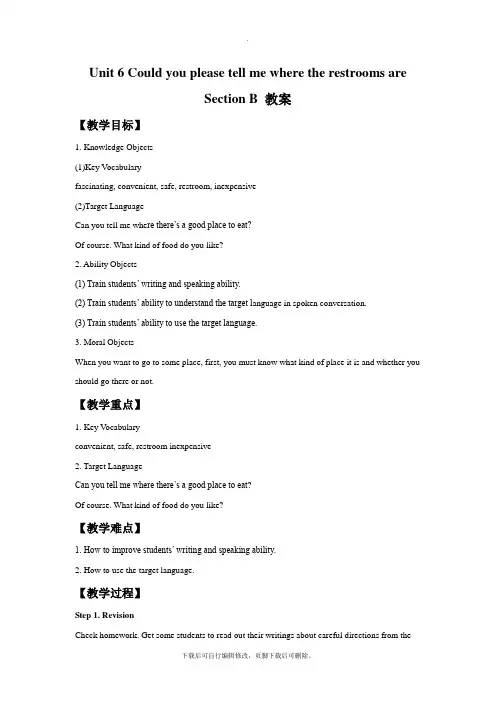
Unit 6 Could you please tell me where the restrooms areSection B 教案【教学目标】1. Knowledge Objects(1)Key Vocabularyfascinating, convenient, safe, restroom, inexpensive(2)Target LanguageCan you tell me whe re there’s a good place to eat?Of course. What kind of food do you like?2. Ability Objects(1) Train students’ writing and speaking ability.(2) Train students’ ability to understand the target l anguage in spoken conversation.(3) Train students’ ability to use the target language.3. Moral ObjectsWhen you want to go to some place, first, you must know what kind of place it is and whether you should go there or not.【教学重点】1. Key Vocabularyconvenient, safe, restroom inexpensive2. Target LanguageCan you tell me where there’s a good place to eat?Of course. What kind of food do you like?【教学难点】1. How to improve students’ writing and speaking ability.2. How to use the target language.【教学过程】Step 1. RevisionCheck homework. Get some students to read out their writings about careful directions from theschool to each place.Collect their writings and help correct any errors.Step 2. PresentationThis activity provides reading and writing practice using the target language.Go through the instructions with the class.Read the words in the box to the cla ss and ask if there are any of these words that students don’t understand. If so, help students to explain the meaning of the word.Then read the instructions again and point out the sample answer. Get a student to read the sample answer to the class. Point out those students can also write other words after the word clean.Ask students to write words from the box in the blanks on their own. Help students if needed. Correct the answers by having students read what qualities he or she listed.Sample answersPlaces Qualities1. restroom clean, big2. museum interesting, beautiful3. restaurant inexpensive, delicious4. park beautiful, fascinating5. subway safe, convenient6. mall big, uncrowdedStep 3. Pair work1) Finish 1b: This activity provides guided oral practice using the target language. Read theinstructions to the class. Point out the example in the box. Invite two students to read itto the class.S A: The Fine Arts Museum is really interesting.S B: Yes, and it’s beautiful, too.Now work with a partner. Look at the words in the box and use them to talk about places in your own city. As students talk, move around the classroom checking their work. Offer language support as needed. Invite several pairs of students to say their conversations to the class. Conversation 1:S A: Supermarket is really big.S B: Yes, and it’s inexpensive, too.Conversation 2:S A: Cinema is very clean.S B: Yes, and it’s beautiful, too.2) Finish 2b: Point to the story. Look at the words indicated in bold. Ask different students to guess the meaning. Don’t give them the correct answers. Ask students to read the article once. Say, pay attention to the bold words and expressions. And note any other words or sentences, you don’t understand. Read in context, guessing their meanings from the other words around them. Ask students to read the article again for comprehension. Read the instructions with the students and have them look at the example. Then ask students to match the correct meanings with the correct words and expressions. Allow them one or two minutes to do this. Check the answers: Get students to make sentences with the words and expressions.Remind them to look at the article again for extra help.Answers to this activity will vary. Then ask students to write his/her answers on the blackboard. Help correct any mistakesStep 4 HomeworkFinish Self Check and remember the new words and expressions.。
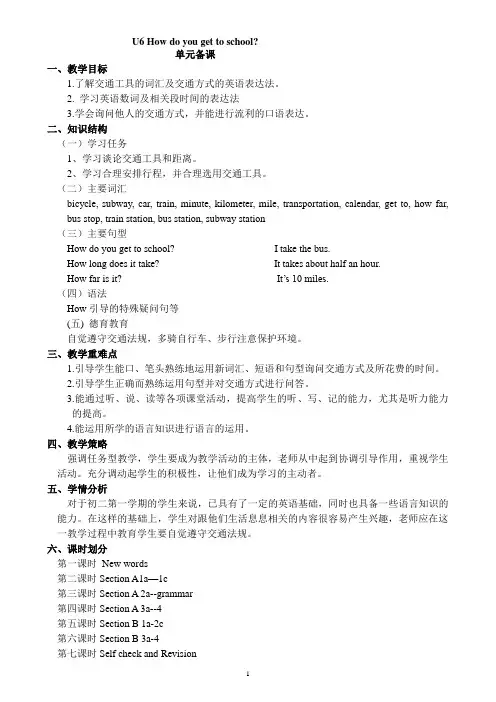
U6 How do you get to school?单元备课一、教学目标1.了解交通工具的词汇及交通方式的英语表达法。
2. 学习英语数词及相关段时间的表达法3.学会询问他人的交通方式,并能进行流利的口语表达。
二、知识结构(一)学习任务1、学习谈论交通工具和距离。
2、学习合理安排行程,并合理选用交通工具。
(二)主要词汇bicycle, subway, car, train, minute, kilometer, mile, transportation, calendar, get to, how far, bus stop, train station, bus station, subway station(三)主要句型How do you get to school? I take the bus.How long does it take? It takes about half an hour.How far is it? It’s 10 miles.(四)语法How引导的特殊疑问句等(五) 德育教育自觉遵守交通法规,多骑自行车、步行注意保护环境。
三、教学重难点1.引导学生能口、笔头熟练地运用新词汇、短语和句型询问交通方式及所花费的时间。
2.引导学生正确而熟练运用句型并对交通方式进行问答。
3.能通过听、说、读等各项课堂活动,提高学生的听、写、记的能力,尤其是听力能力的提高。
4.能运用所学的语言知识进行语言的运用。
四、教学策略强调任务型教学,学生要成为教学活动的主体,老师从中起到协调引导作用,重视学生活动。
充分调动起学生的积极性,让他们成为学习的主动者。
五、学情分析对于初二第一学期的学生来说,已具有了一定的英语基础,同时也具备一些语言知识的能力。
在这样的基础上,学生对跟他们生活息息相关的内容很容易产生兴趣,老师应在这一教学过程中教育学生要自觉遵守交通法规。
六、课时划分第一课时New words第二课时Section A1a—1c第三课时Section A 2a--grammar第四课时Section A 3a--4第五课时Section B 1a-2c第六课时Section B 3a-4第七课时Self check and Revision。



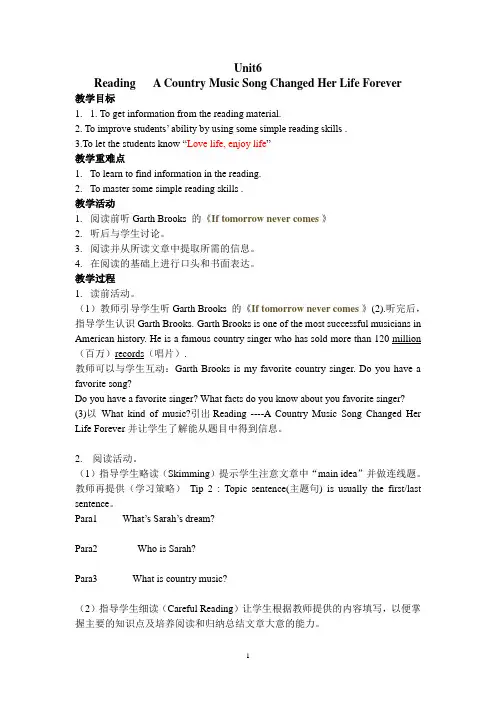
Unit6Reading A Country Music Song Changed Her Life Forever教学目标1. 1. To get information from the reading material.2. To improve students’ ability by using some simple reading skills .3.To let the students know “Love life, enjoy life”教学重难点1.To learn to find information in the reading.2.To master some simple reading skills .教学活动1.阅读前听Garth Brooks 的《If tomorrow never comes 》2.听后与学生讨论。
3.阅读并从所读文章中提取所需的信息。
4.在阅读的基础上进行口头和书面表达。
教学过程1.读前活动。
(1)教师引导学生听Garth Brooks 的《If tomorrow never comes 》(2).听完后,指导学生认识Garth Brooks.Garth Brooks is one of the most successful musicians in American history. He is a famous country singer who has sold more than 120 million (百万)records(唱片).教师可以与学生互动:Garth Brooks is my favorite country singer. Do you have a favorite song?Do you have a favorite singer? What facts do you know about you favorite singer? (3)以What kind of music?引出Reading ----A Country Music Song Changed Her Life Forever并让学生了解能从题目中得到信息。
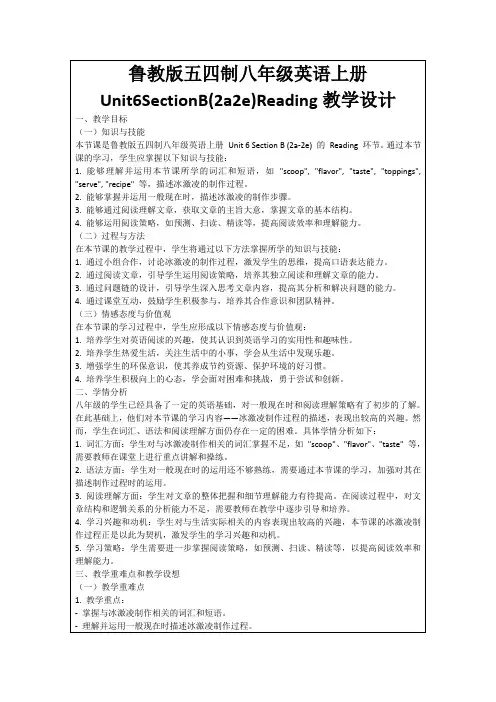
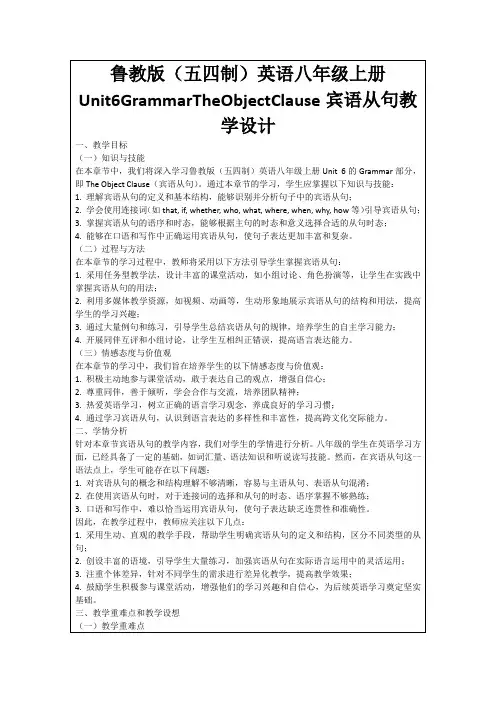
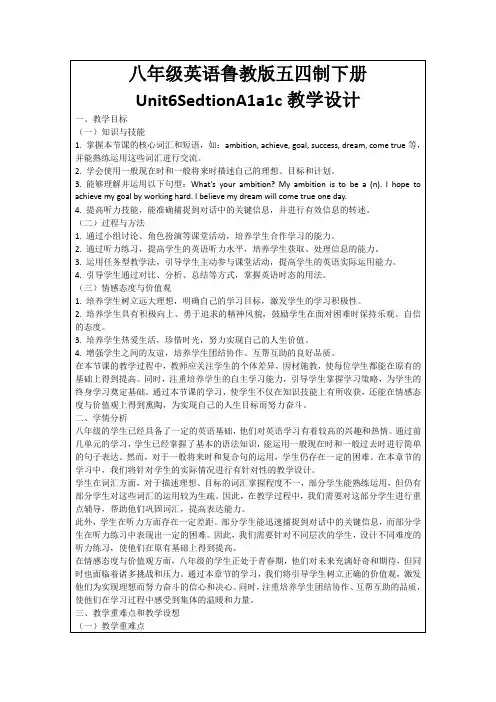
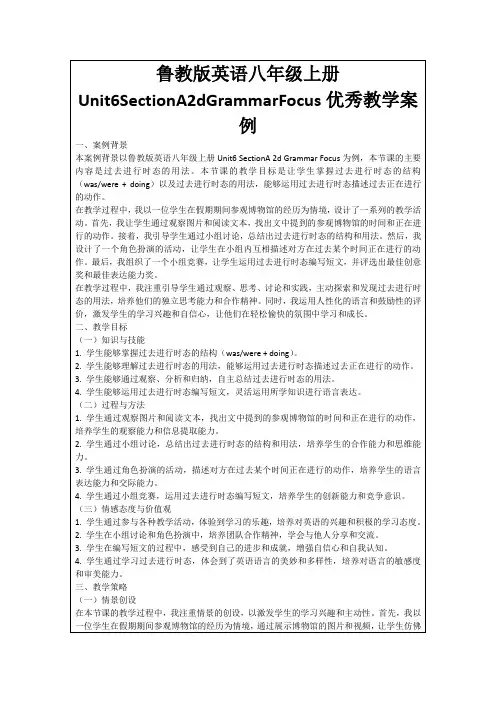
U6 How do you get to school?
单元备课
一、教学目标
1.了解交通工具的词汇及交通方式的英语表达法。
2. 学习英语数词及相关段时间的表达法
3.学会询问他人的交通方式,并能进行流利的口语表达。
二、知识结构
(一)学习任务
1、学习谈论交通工具和距离。
2、学习合理安排行程,并合理选用交通工具。
(二)主要词汇
bicycle, subway, car, train, minute, kilometer, mile, transportation, calendar, get to, how far, bus stop, train station, bus station, subway station
(三)主要句型
How do you get to school? I take the bus.
How long does it take? It takes about half an hour.
How far is it? It’s 10 miles.
(四)语法
How引导的特殊疑问句等
(五) 德育教育
自觉遵守交通法规,多骑自行车、步行注意保护环境。
三、教学重难点
1.引导学生能口、笔头熟练地运用新词汇、短语和句型询问交通方式及所花费的时间。
2.引导学生正确而熟练运用句型并对交通方式进行问答。
3.能通过听、说、读等各项课堂活动,提高学生的听、写、记的能力,尤其是听力能力
的提高。
4.能运用所学的语言知识进行语言的运用。
四、教学策略
强调任务型教学,学生要成为教学活动的主体,老师从中起到协调引导作用,重视学生活动。
充分调动起学生的积极性,让他们成为学习的主动者。
五、学情分析
对于初二第一学期的学生来说,已具有了一定的英语基础,同时也具备一些语言知识的能力。
在这样的基础上,学生对跟他们生活息息相关的内容很容易产生兴趣,老师应在这一教学过程中教育学生要自觉遵守交通法规。
六、课时划分
第一课时New words
第二课时Section A1a—1c
第三课时Section A 2a--grammar
第四课时Section A 3a--4
第五课时Section B 1a-2c
第六课时Section B 3a-4
第七课时Self check and Revision。